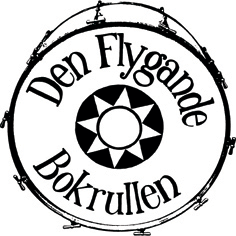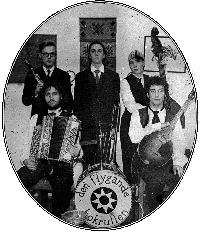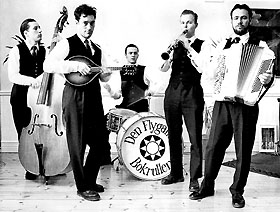

An early
photo, dated using the C14 method to
approx. 1994 AD
Den Flygande Bokrullen
The group started out as a duo in the University town Uppsala in the early nineties with the members Matti Pohjola and Gustav Johansson. Back then we had many different kinds of folk music on our repertoir. What really opened up our eyes for klezmer music was the tune Bobrikov (actually a version of the tune Khsidishe Nigun by Boibriker Kapelle) by the Swedish group Norrlåtar, and the album Metropolis by the Klezmorim. The record was found by Oskar in the record collection of the pohjola brothers' mother. The group became a quintet in 1994 when the founders' younger brothers, Oskar Pohjola and Carl Johansson (now Carl Lindecrantz), and a friend, Lars Ydgren joined. In 1999 the new bass player Arvid Petterson joined when Oskar left the group and moved to Gothenburg. Today Arvid plays piano and baritone horn in the group. The bass player since 2003 is Thomas Dawidowski.
The current line up is:
Carl Lindecrantz: drums & baritone horn
Arvid Pettersson: piano & baritone horn
Thomas Dawidowski: double bass & tuba
Gustav Johansson: accordion, baritone horn & trombone
Matti Pohjola: mandolin, banjo, cornet & baritone horn
Lars Ydgren: clarinet & alto sax
Since 1997, when the band had a gig at Copenhagen Jazz House, Denmark, DFB have been playing at several international festivals, for example in Vienna, Warsaw, Bremen, Lublin, Oslo, Zabkovice Slaskie, Kazimierz Dolny and Fürth as well as clubs (Berlin, Leipzig, Halle, Lodz etc) and pubs (the band of course does domestic gigs regularly). At the klezmer festival in Kazimierz Dolny (PL), DFB were chief workshop-instructors.
During the years Den Flygande Bokrullen have also appeared at different media as television, radio etc innumerable times, recorded three full lenght albums and one electronic-based ep, made a film about the group’s origin, played in front of the king and queen as well as crown princess Victoria and been sampled by hip-hop groups. However, we have not left our basics as we still play at weddings and other parties. Today the six members of the group live in and outside of Uppsala and Stockholm.

A photo from the time when Den Flygande
Bokrullen still only was available in black and white.
This was February 1998
Klezmer
Klezmer is a form of music that has now gotten a second reneissance (The first one was in the late seventies). It is an unique mix between many different folk music styles, mainly jewish, gypsy, and east- and central European. Other forms of popular music have also contributed to the klezmer sound. The word klezmer comes from kley-zemer which is hebrew for musical instrument, but later on it has gotten the meaning travelling musician. The earlier klezmorim (pluralis of klezmer) were travelling musicians who, a bit like gypsies, travelled through most of the countries of eastern Europe, for example Russia, Poland, Romania, Bulgary and Hungary. They took influences from all those cultures and incorporated them into their music.
Klezmorim were often hired to play their music on weddings and other festivities, jewish but also non-jewish. The klezmer music came to USA with jews who fled the growing pogroms against the jews in Europe. Since it is one of the main attributes of the klezmer music to get influenced by other styles of music, it once again got influenced by the music of that era, in this case american popular music of the early nineteenhundreds, like Jazz.
Den Flygande Bokrullen has followed the traditions of klezmer music and let our music get some colour from the group members' own musical favourites and preferences. For example, we play many greek tunes, just like the revival-pioneer group Klezmorim did on their first record. The Hasaposerviko, for example, mixes well with klezmer music because of its energy and jolliness.
